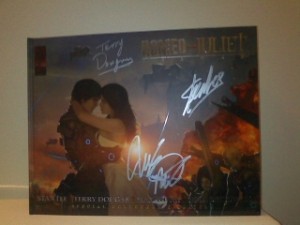Recently, I attended a book signing in Los Angeles hosted by none other than the name among names, the one and only Stan Lee. The living legend was there promoting one of his most recently completed works, Romeo and Juliet: The War, a futuristic adaptation of William Shakespeare‘s arguably most renowned play. Previously available primarily at conventions, this graphic novel was sold in a hard cover coffee table book styled special collector’s edition.
While waiting in line for Stan to arrive, I was given ample time to peruse the book I had just purchased and see how The Man matches up to The Bard. The first thing one notices upon opening the book is the perpetually spectacular artwork by Skan Srisuwan. He fills the pages with stunning splash pages and breathtaking futuristic cityscapes, making the artwork alone worth the price of the book. Once one begins reading the comic, they learn that in this futuristic Verona the Montagues and Capulets are warrior classes; specifically cyborgs and genetically enhanced humans, making their family relations closer in comparison to West Side Story than the original play.
Stan Lee and Terry Dougas‘ writing style works well in tandem with Shakespeare’s original vision. The humor of the original play often missed by modern audiences is brought to the front with witty and biting dialogue in this new iteration. They also make a point to note the ridiculousness of the “eternal love” forged between the star-crossed lovers after only a night’s acquaintance, another aspect often overlooked by readers today.
Romeo and Juliet: The War may not add anything significant or insightful to the original play, however similarly to Baz Luhrmann‘s 1996 cinematic interpretation, it portrays the tale in a fresh new way that brings the classic tale to a new age, and will entice old fans and modern readers alike.
In getting my copy of the book signed, I was unable to get any good pictures with or of Stan, however I did have sufficient opportunity to ask him one question while he and the other creators signed my book. Seeing this as a once and a lifetime chance to ask the godfather of modern comics a single question, I endeavored to make sure it counted and that it would be a hard hitting question. As the line slowly wound closer, the butterflies in my stomach grew larger and larger; and I began to recite the chorus to Mulan‘s I’ll Make a Man Out of You repetitively in my head as a mantra in order to help keep my composure.
Finally my turn arrived, and I shakily walked up to the table, abandoning hopes of getting my copy of Mallrats signed, I instead focused fully on getting my question answered. Standing before him, I was able to spurt out:
“Hello Mr. Lee.”
“Great Shirt!” he responded, noting my blue on black Fantastic Four t-shirt, causing me to grin from ear to ear before choking out a polite “Thank You.”
Leaning in, I asked him “Would you be able to answer a quick question for The Mary Sue.com?”
Without hesitation, he replied “Sure. Just speak up a bit, I canít hear too well anymore.”
With little to no level of cadence, I began the set up to my question, stating:
“Your most renowned female characters have been primarily auxiliary characters to teams or male counterparts — ”
“They’ve been what kind of characters?” he asked.
“Auxillary.” I repeated.
“Angelic?” he inquired, clearly confused.
“Auxillary.” I reiterated again, as did Terry Dougas, who sat next to him.
“Oh, okay.” He said, now comprehending.
With him now caught up, I repeated the set up to my question, and continued,
“Why is it you have created so few strong, female characters who were made to stand on their own? And why are there so few solo titles with female leads?”
In completing my question, I felt as if I had just asked Santa Claus who gave him the right to judge who was naughty and who was nice.
After pausing a second, Stan graciously replied,
“You’re right. There aren’t that many. The thing is that most people who buy comics are guys. The publishers and the companies worry that there isn’t enough interest in female characters, and that because of that not enough people will buy a solo female title.”
At this point I was swept forward by the oncoming line, my time with Stan clearly at an end. Unfortunately, this meant that I was unable to follow up his answer and ask whether his view on the topic represents the comics industry currently, or if he was speaking on the early days of Marvel. Worse, if he was insinuating the former, then I missed an opportunity to enlighten one of the leaders in the comics industry of the large and ever growing female fan base, as well as the clamoring for more titles based on female characters.
Christopher Holden blogs here.








Published: Apr 6, 2012 12:30 pm